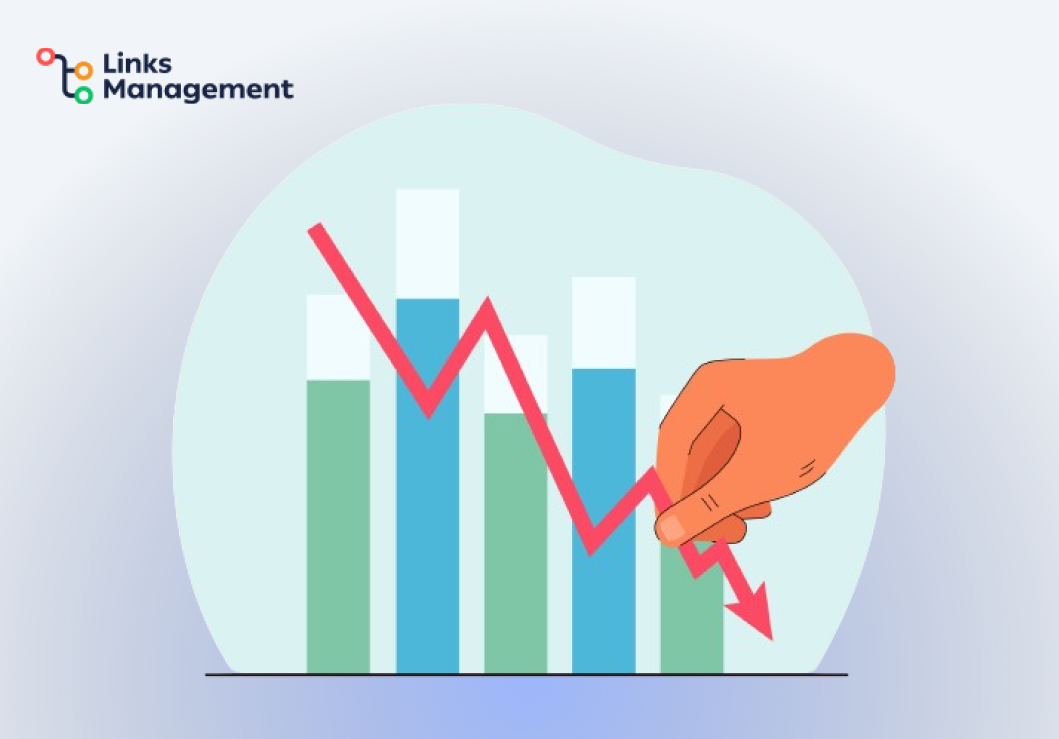Traffic Troubles: Investigating the Causes Behind Website Visitor Loss
Webmasters and website owners always strive to increase the number of visits to their resources. The reasons are obvious: firstly, the more visitors on the site, the higher the likelihood that someone will seek a service or buy a product; secondly, with the growth of traffic, the potential opportunity arises to place advertising on the site, the price of which directly depends on the number of visitors. In addition, increasing traffic helps improve the site’s position and promote it to the TOP 10.

Unfortunately, problems often arise when previously stable or growing traffic begins to fall or stops growing for no apparent reason. If the negative dynamics are consolidated and website traffic dropped suddenly, immediate solutions are necessary.
Reasons for the Drop in Traffic
Before eliminating the problem, it is necessary to identify the causes that bring website traffic down. Currently, there are no fully automated systems that solve this problem. They are identified by search engine optimization specialists, using their experience, various web mastering tools, and search analytics services.
Traffic can drop for various reasons, more or less evident and understandable ones, including:
- Significant changes to the site, such as changing the design or structure, moving to another hosting, or changing the content management system (CMS).
- Seasonal decline in activity. Many goods and services are popular with consumers only during a certain period of the year.
- Decreased interest in a topic that is not related to seasonality. For example, something similar happened with cryptocurrency.
- Website hacking or attack. Such actions may not always be noticeable to the average person.
- Falling positions in the TOP 10 of Google.
Suppose the situation does not fall under one of the above. In that case, the crux of the matter usually lies among the internal factors of search engine optimization, of which there are many.
A sudden drop in website traffic is usually associated with problems that can be divided into three groups: content, links, or behavioral factors. Next, we will analyze each group in more detail.
How to Detect the Reasons
If you ask, “Why is my website losing traffic?” first, go to GSC — Pages. Here, you will see website traffic info and statistics on what is included in the index, what is not, and why. Next, the reports will be studied, and the cause identified. Documents can be indexed, and despite the prohibition in robots.txt, such a block is also available in the Console. The fact is that with prohibitive rules in robots, crawlers cannot scan the content. However, the decision whether to add a page to the database or not is always theirs. If they lack information, they may not make the choices you expect. Therefore, using canonical links for some types of pages is better.
Site Content Analysis
One of the most critical components of search ranking is the site’s text content. If traffic has decreased, what should you pay attention to regarding website content?

Spaminess
A site can be demoted in search results, and, as a result, traffic can be reduced because of the publication of a large amount of spammy text. Therefore, it is necessary to check the text material of the main pages for spam, that is, for the excess use of keywords.
When studying competitors whose resources occupy the first lines, it’s good to analyze the text’s semantic indicators. If your indicators differ significantly from theirs, comparing them with competitive ones makes sense.
Semantics
Specialized SEO optimizers allow you to download the semantics of sites of interest and determine the frequency of requests with which competitors’ pages are promoted. In addition, it is useful to analyze whether sites from the TOP search results use direct or diluted occurrences of keys.
Also, when analyzing semantics, it is worth paying attention to how groups of requests are interconnected with the resource’s structure. In practice, individual pages dedicated to a specific cluster of requests are better promoted. Large pages, where several blocks of thematic queries are concentrated at once, progress worse.
Structure, Location, and Volume
When comparing your site with competitors, you also need to pay attention to such aspects as:
- Text size. If you identify clear patterns, for example, when all sites use texts of 3-5 thousand characters from the first lines and only have a small description of 500 characters, you should adapt to the trend and increase the text volume.
- Placement of text on the page.
- Subheading structure: You need to pay attention to the presence of key phrases in the H1 and H2 headings.
Uniqueness
When you have a question, such as “Why is my website traffic dropping?” the reason can be simple. One of the critical points in search engine promotion is the use of unique texts.

Non-unique texts can be published either consciously or through the fault of, for example, a copywriter who did his job in bad faith and slipped someone else’s texts to the customer. And he, without bothering to check the result, published the transmitted texts on his website. This happens when customers delegate tasks to dubious freelancers. Once in the index, the abundance of plagiarism subsequently harms promotion, even leading to sanctions from search engines.
This problem can be solved by taking a more responsible approach to checking texts or ordering them on exchanges where the work of copywriters undergoes quality control.
A more complex situation arises when, without the knowledge of the copyright holder, the material is published on other sites. Yes, in most cases, this does not harm the original source since search engines understand who owns the rights to the content. But it happens, especially with young projects when their materials are published by a trusted site that uses the mechanics of the so-called “black hat SEO”.
The point is that texts are intercepted immediately after publication, that is, before they are included in the search engine index. As a result, robots believe that the content belongs to another site.
External Link Profile
Search engines are actively fighting manipulations that are carried out with links. The requirements for external links are stringent, and very often, this is where the reason for falling traffic lies.
Competitive Attack
First, you need to study the link profile. If referrals from other sites have increased suspiciously, this may signal an attack by competitors. Thus, sites are artificially subjected to sanctions by algorithms. That is, a competitor can place many anchor links leading to your site on garbage resources. By search engine algorithms, quickly and extensively placing links on various sites with a bad reputation is often considered as manipulation. As a result, you are lowered in search results and sometimes fall under the anti-link filter.
The black method of drowning competitors by cheating behavioral factors works similarly. However, it is more common with links because it is much easier to implement. Therefore, it is essential to monitor the dynamics of your link profile and, if suspicious activity occurs, contact search engine support services so that they can take action before this happens automatically and negatively toward your site.
Errors in Working with External Links
Sometimes, website owners harm themselves, even without the participation of competitors, by independently placing an excessive number of anchor links. It is necessary to understand that link building is one of the main tools of spam promotion, and search engines pay increased attention to it.
To avoid excess, it’s helpful to look at how the top search results are doing. It is done with the help of link analyzers, which help to download the anchor lists of competitors and compare the density of your anchor links, subsequently focusing on the TOP-3.
Based on the situation, the dense anchor mass is either diluted with non-anchor structures and crowding, or they approach the issue radically and remove unnecessary links. If the number of links, on the contrary, is too small, then it makes sense to expand the link profile.
The quality of backlinks depends on the authority of the site where they are located. Check donor sites and strive for diversity. Remember that a site can promote well up to a certain point, but as soon as the link imbalance reaches a critical mass, problems can begin.
Checking and Optimizing Behavioral Factors
Behavioral factors are the main search ranking criteria today. Their negative changes are very likely to lead to loss of traffic on my website.
Among the main behavioral metrics are:
- failures;
- viewing depth;
- time on site;
- search returns;
- % scrolling;
- reposts on social networks.
What should you pay special attention to when analyzing behavioral factors, and what measures should you take to implement them?
Analysis of Dynamics of Visitor Loss
You know how to find out how much traffic a website gets. Analyzing losses has the exact mechanism. First, familiarize yourself with the statistics on the loss of weak pages. If negative dynamics are identified, determine what is behind them.
Possible reasons for the increase in losses may include:
- changing page content;
- obsolescence of content (competitors now have material that is more satisfying to the user);
- page loading speed has slowed down;
- there was a deterioration in usability (the site became less convenient due to an unsuccessful upgrade).
Number of Brand Requests
Branded queries are an important positive signal for search engines. If they are absent or decreased, the site begins to rank worse. Monitor the statistics of search phrases. Brand awareness is developed through crowd marketing, PR management, SMM, and contextual advertising.
Reducing the Duration of User Sessions
Reducing the user’s time on the site is presented in the following ways:
- Content marketing is the creation of valuable and interesting content.
- Optimization of internal linking.
- Improved main navigation.
- Cross-content on pages, for example, recommendations “Read on the topic,” “Most popular,” etc.
- Gamification, tests, surveys, and other ways to retain visitors.
Returns to Search
If a user, having visited your site, spends very little time on it and returns to the search, continuing to look for an answer to the same question, then this serves as a signal to search engines that your resource does not satisfy the request. An increase in the number of search returns can lead to a decrease in search results and a reduction in traffic.
The reasons here are similar to the reasons for failures:
- page one traffic does not match the request;
- the content of the page has changed;
- the content has lost relevance.
Conclusion
All websites experience a drop in traffic from time to time. Unfortunately, even well-optimized resources with original content that do not abuse external links are not immune from this. The principles of search internet traffic rankings simply change, and what previously did not matter or help the site begins to harm it. However, more often than not, the crash problem is related to the mistakes of webmasters and optimizers.
In most cases, attendance can be returned to previous levels and increased quickly. The main thing is to detect and eliminate problems that arise promptly. If suddenly you are faced with a sharp decrease in traffic, do not panic and conduct a comprehensive SEO audit of the resource, which will help identify critical shortcomings on the site. If you are promoting your resource yourself, we hope our tips in the article will support you.
Enter URL & See What We Can Do Submit the form to get a detailed report, based on the comprehensive seo analysis.





